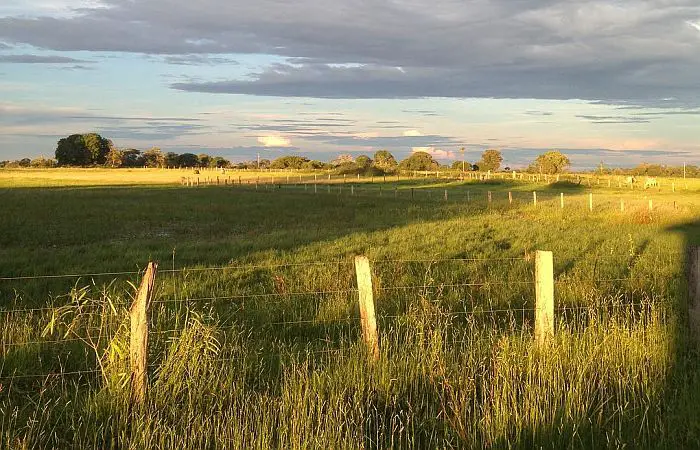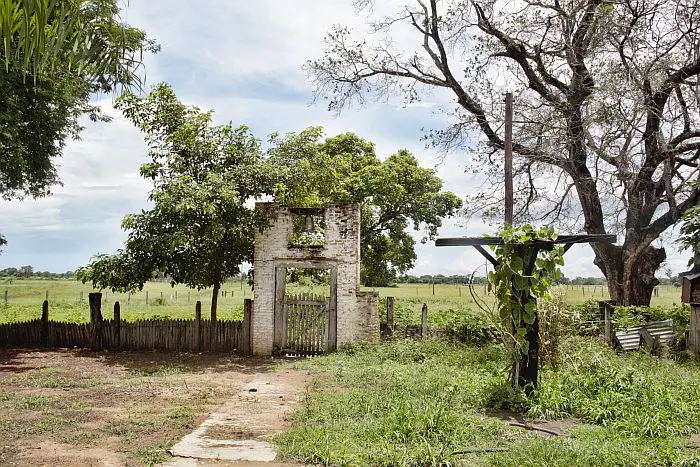Hunting Wild Boar in the Brazilian Cowboy Country of Pantanal
By Madelaine Triebe
After getting the luxe treatment at a nature lodge on a previous Pantanal visit, meeting the Brazilian boyfriend's farm family is a different story.

"Mata onça, mata onça," he says with wide eyes and great emphasis on mata (kill) talking to his two-year-old son with big dark eyes, long eyelashes and a wooden rifle in his hand.
"Pwow, pwow," says the boy imitating the sound of a rifle going off.
 "O que você vai matar?," says Brasinha, the father and also the farm manager of Fazenda Maringá to where I have just arrived, to his son and repeats the question. "O que você vai matar?"
"O que você vai matar?," says Brasinha, the father and also the farm manager of Fazenda Maringá to where I have just arrived, to his son and repeats the question. "O que você vai matar?"
"What are you going to kill?"
"Poico, oncja," says the boy wearing little brown leather boots while stamping around the ground with his little feet.
"Pig and jaguar."
It's my first day at the farm in Pantanal—the world's biggest freshwater land, predominantly situated in Brazil. I'm here with my Brazilian boyfriend and his friend Thiago, visiting their mutual friend Vinicius and his family's fazenda (ranch) deep in the wetlands.
As we arrive we are immediately greeted by the family. There's Vinicius, his father, his mother, his younger brother and the farm manager Brasinha together with his wife and his son. We are all standing there outside the simple farm house listening to Brasinha interacting with his son. My boyfriend tells him something in Portuguese and points at my t-shirt. The bearded farm manger turns around and looks at me with big eyes and after a few seconds of silence and a theatrical pause he says: "Nooooo conservaçaaaaoooo, conservaçaaaaoooo," elongating the Portuguese word for conservation and everyone breaks out in loud laughter.

My Levi's denim shorts I'm wearing and my beige t-shirt with UV protection and a green map of Brazil and jaguar face on it promoting jaguar safaris in Pantanal, now a t-shirt that everyone at the farm is familiar with, feels like it's from a different world.
I'm a travel writer and I have spent the last three months researching places to eat, sleep and drink in Brazil for a travel guidebook. As the laughter slowly dies out I understand that my three-day visit to Pantanal this time, to a farm with no tourists in sight, will be a completely different experience than my five-star luxury introduction to the wetlands a couple of months ago.

From Binoculars to Belt Buckles
It's the day before New Year's Eve and I have just arrived at the farm after a ten-hour journey and it's in the middle of the rainy season in Pantanal. The previous night I left Campo Grande, the capital of Mato Grosso do Sul in the mid-west of Brazil. Instead of showcasing the conventional tourist brochure pictures of smiling samba dancing Brazilians and white beaches, Mato Grosso do Sul is the Texas of Brazil. Big cattle ranches, Wrangler jeans, cross checked shirts, big belt buckles, and wide cowboy hats are a common sight, particularly outside the city.
Leaving Campo Grande I'm not really sure where in the Pantanal I'm going, what it will look like, or even how long it will take to get there. It doesn't seem like my boyfriend or his friend Thiago has a very good idea either. Nothing has gone as planned since we left the city. We shove the packing in the back of the pickup into the four-wheel-drive we hope is going to take us all the way from the city to the farm, though it's in the middle of the rainy season and the water levels are high. Roads and bridges are covered with water or are so muddy it takes some serious driving skills to maneuver the slippery surface, something I will realize the following day that my boyfriend does not have.

We stay the night in Aquidauana—a small town of roughly 45,000 inhabitants and just on the border to Pantanal‐and continue into the wetlands in the morning. The first stretch is easy. We drive on dry dirt roads surrounded by farms, trees and cattle in lush pastures. I think to myself that it's not that bad. "Why do people go on about the rainy season?," I ask myself; there's not really any water.
But after an hour of driving we encounter our first hurdle. The first wooden bridge we get to looks like it can't hold a bicycle, let alone a one-ton Toyota Hilux 4x4 Turbo. My boyfriend, who's driving, decides to go around it. He looks at Thiago to his side, then to me, asks us if we are ready and drives straight into the water. We get stuck in the middle and the murky water slowly starts seeping into the car. Soon the whole car floor is wet and my boyfriend waddles out into the water to get help from the local cowboys working at the farm close by. Luckily it's just a five-minute walk away. They come with a tractor, driving over the bridge we decided was too weak to handle heavy vehicles, ask us puzzled why we didn't use the bridge, and pull us out of the water with the tractor. We get stuck a second time 30 minutes in mud and after an hour trying to get out of it we get help from the tractor again.
Copyright (C) Perceptive Travel 2018. All rights reserved.
- In Greece, Things Happen by David Lee Drotar
- The Life of a Backpacker in Asia in the 1970s by Kevin Kelly
- The Kidnapping of Edward the Maasai by Claudia B. Flisi
- Travel Book Reviews by Susan Griffith
Books from the Author:

Buy The Rough Guide to Brazil at your local bookstore, or get it online here:
Amazon
Kobo

